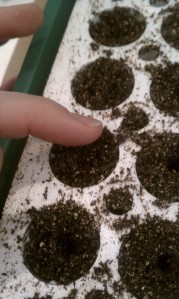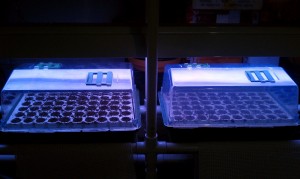Money may not grow on trees, but it does grow in your garden!
“HO-LY-COW! You’ve got to be kidding me!” Oh, geeze, did I really say that out loud? I quickly glanced around the store, avoiding any eye contact with anyone who may have heard or at the very least seen my face when my eyes popped out of my head and my jaw hit the floor. My eyes stop. A woman is looking at me with a concerned, or maybe it’s disgusted, look on her face. I’m busted. I smile a sheepish smile and bolt from the produce section, round the corner to the next aisle with incredible speed, and pretend it never happened. I stop and stare at a shelf of products I’m not even remotely interested in eating, much less buying, but I look like I’m focused on making a decision. What’s really going through my mind is that if I breathe slow enough the blood in my flushed cheeks will begin to flow back down into the rest of my body… and…. I cannot wait to get my garden started! I’m so tired of paying through the nose for produce when I could grow the same thing at home… for so much less! Okay, so maybe I couldn’t grow them now, but in the summer I could. I really should start my seeds…
That’s when I realized, nobody (except for maybe the appalled lady in the produce section) can afford not to plant an edible garden! I’m serious! Think about it. When you go to the store, a, one, single, organic green pepper can easily cost between $2 and $3. Make a meal using 3 or 4 of them and you’re talking $10 to $12 that’s just for the peppers. That’s not to mention the other ingredients. Yikes! (And if I haven’t convinced you to convert some of your purchases to organic yet, those conventional peppers aren’t too far behind.) You can get so much more for so much less money in a garden, or a pot, or a bucket for that matter.
As I’m absorbed in thought about how gardens can solve all the worlds problems, I see this lady, not the produce section lady, but another lady. Not all that much more friendly looking either. She’s floating, hovering, covered in dust, no, its dirt, er, um soil, and leaves and straw… What on earth?!? She identities herself as the Ghost of Gardens Past. She takes me by the hand and drags me on a little garden tour. She shows me my failures. The planned, but not planted. The planted, but not watered. The watered, but not harvested. The wasted spaces that could have been a home for edible plants, but have nothing. “Wow… Right… ” I think to myself, “I guess I shouldn’t be complaining about the prices. Got it. Can I continue my shopping now?” Much to my amazement she disappears. I start down the next aisle, looking back over my shoulder, wondering this time not if people saw my face, but if they saw this woman, this Ghost. I’m also checking to make sure she doesn’t pop out of nowhere again. Nobody appears to be alarmed. I shake it off.
Thinking about my chance meeting, I round the next corner to find a woman covered in produce. Not again… But I notice this one is pretty, not angry and haggard looking like the first one. Peppers hang from her short sleeves, or maybe they are her sleeves. Broccoli or broccoli-raab looks like flowers in her auburn hair. I look closer, her dress, the many layers upon layers of greens are… greens! Oak lettuce, butter lettuce, arugula and spinach. Uh oh, I’m being whisked away again. This time we fast forward a couple of months. I follow this Ghost of the Future Gardens. The weather is glorious. The garden centers and nurseries are buzzing with activity, we’re cruising the aisles looking at the transplants, because, back in March it was so unseasonably warm I completely forgot to order seeds, or did I buy them but forgot to plant them? I don’t recall. Now I kick myself a little as we look at the price of the green pepper plants. Really? Seriously?!? $4.50, $6 or $7. “Forget it!” I think. “I’ll wait until they go on sale in July. Or buy peppers at the Farmer’s Market. ” I love the Farmer’s Market, so I quickly justify to myself why this make sense. But the Ghost stops me. I turn right around and try to grab that plant, but I can’t. My hand goes right through it like it’s not there. I’m disturbed. We move on to the Farmer’s Market it’s mid-July or maybe August. I see myself across the way. Buying everything under the sun. What am I doing?! “You have a garden at home. You don’t need all that stuff!” I yell to myself. “A little, maybe, but look at that!” She takes me to the grocery store, where I buy more. “Look at those tomatoes! They’re not even ripe! What are you doing? Look at the money you’re spending!” Confused, I look to my Ghost. She said I never planted a garden… I never planted my seeds… I was too busy enjoying the warm weather in March. Then she takes me to my family’s gardens, friends gardens… they’re picking cucumbers and tomatoes and peppers! The peppers! I’m green with envy.
I come to in the refrigerator section. A chill comes over me. I think about my dream. It was a dream, right? Then I see the peppers in my cart. I bought 4 peppers for dinner and it cost me $12! I could buy two pepper plants for the same price and even if I only get two peppers on each plant I’ll break even. More than that, I’m ahead. I’m for sure buying transplants if don’t get my seeds started. But think, I paid $2.75 for a packet of seeds. I could get way more than 2 plants from that packet that I paid $2.75 for and just think of how many peppers I could get! Now we’re talking. That’s some serious frugal shopping, right?
But it’s not over. The Ghost of Present Gardens comes up the aisle motioning for me to follow. I look back to make sure she’s looking at me, or more realistically, hoping she’s looking for someone else even though I know better than to believe that at this point. My new ghost is adorned with seed packets and trowels and garden twine serves as a belt around her burlap potato sac dress. Somehow the pot she wears upside down for a hat looks appropriate. She takes my hand and guides me home. She shows me the seeds and the soil and the plant lights. All sitting empty. She points to my garden calendar, to March 20th with my note “start seeds” and an arrow carrying through to April 3rd. She flips the page to May. She points to the 15th with my note “Avg. last frost – Plant!”. She takes me out into my back yard. The lawn is greening, trees are budding, perennials are popping up everywhere. Rhubarb is poking up, asparagus is growing in front of my very eyes. Then she takes me to my veggie garden. It’s right where I left it last year. She walks me down the block where neighbors are cleaning out their gardens, getting ready for the season to start. I say “Hi! Beautiful weather! Can you believe this?!?” They can’t hear me. She shows me my friends, neighbors even people I don’t know, starting seeds. She shows me my son. Telling his teachers and friends how much he loves to grow things, but then tells people we aren’t growing anything from seed this year, “My mom is too busy.” he says. Suddenly I feel sick. I don’t want to see any more.
I wake up to today. Oh, my gosh! What day is today? What’s the date? Today is March 21st, the first official full day of spring. It’s not too late! It’s 8 weeks before I normally plant warm season crops like peppers in the garden. I can plant my seeds! Woo-hoo!!! HAPPY SPRING EVERYONE!
In case you didn’t follow all of that… the moral of the story is: Get out there (or in there) and get planting! Get those seeds started! And if you don’t “do seeds” then buy (organic) transplants later this season or you’ll continue to pay huge prices for produce. And don’t forget to keep it all in perspective – all the prices are relative. Seeds are cheap because we do the work from the beginning. We take the risk of losing a few. Transplants cost us a little more because someone else took the risk and nurtured them for the first part of their lives until we buy them. When buying transplants we take on their costs, loss and overhead to grow them, transport them, etc. And if we buy at the Farmer’s Markets then they took it all on. They grew the plants from the beginning until they produced fruit (or veggies) for us to buy. They deserve what they charge, they’ve earned it. And the organic producers who supply the grocery stores? They take on all the risk too. The extra cash out of our pockets comes from the larger scale… more of everything… more tending, more overhead production costs, more transportation costs, more people costs, not to mention the grocery store or co-op wants a cut too.
So, if you learn nothing else from my crazy co-op experience. Please take away that you could stash a lot of cash in your pockets this summer by simply planting an edible garden. Even if it’s just a container of patio tomatoes, think of the bang you’ll get for your buck! So maybe money doesn’t grow on trees, but plant yourself an edible garden and it will feel like it grows in the garden.
This completes the lesson on why you can’t afford not to plant an edible garden this year. The green peppers and ghosts in this story were fictional. The prices reflect current market prices at local distributors. Any similarity to actual green peppers, ghosts or distributors is purely coincidental, but if it gets you to get dirty and plant some seeds, then it’s not.
Happy Spring and Happy Planting! Did I mention it’s time to start planting seeds?
Kate














